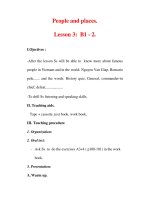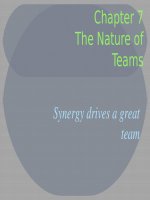Lecture Organizational behavior - Chap 7: Introducing organizational behavior
Bạn đang xem bản rút gọn của tài liệu. Xem và tải ngay bản đầy đủ của tài liệu tại đây (6.48 MB, 43 trang )
Chapter 7
The Nature of
Teams
Synergy drives a great
team
Chapter 7 Study
Questions
What are teams and how are they used in
organizations?
When is a team effective?
What are the stages of team development?
What are the input foundations for teamwork?
Copyright © 2014 John Wiley &
7-2
What are teams and how
are they used in
Team
organizations?
Group of people brought together to use
•
complementary skills to achieve a common
purpose for which they are collectively
accountable.
Teamwork
• Occurs when team members accept and live up
to their collective accountability by actively
working together so that all their respective
skills are best used to achieve team goals.
Copyright © 2014 John Wiley &
7-3
What are teams and how
are they used in
What Teams Do
organizations?
Teams that recommend things
•
Established to study specific problems and
recommend solutions to them.
• Teams that run things
Have formal responsibility for leading organizations
and their component parts.
• Teams that make or do things
Work units that perform ongoing tasks.
Copyright © 2014 John Wiley &
7-4
What are teams and how
are they used in
Formal teams
organizations?
Created and officially designated
to serve a specific
•
organizational purposes.
• May be permanent or temporary and vary in size and
composition.
Copyright © 2014 John Wiley & Sons, Inc.
7-5
What are teams and how
are they used in
Informal groups
Emerge and coexist as a organizations?
shadow to the formal structure
•
and without
any assigned purpose or
endorsement.
• Types of informal groups
Friendship groups
Interest groups
Copyright © 2014 John Wiley & Sons, Inc.
7-6
What are teams and how
are they used in
Social network analysis – organizations?
identifies the informal
groups and networks of relationships that are
active in an organization.
Copyright © 2014 John Wiley &
7-7
What are teams
and how are they
CrossFunctional and ProblemSolving Teams
used in
Crossfunctional teams or task forces
Members brought together from different functional
departments or work unitsorganizations?
to achieve horizontal
•
integration and better lateral relations.
• Problemsolving teams
Created temporarily to serve a specific purpose by
dealing with a specific problem or opportunity.
• Employee involvement team
Meet regularly to collectively examine important
workplace issues
Quality circles meet periodically to discuss and make
proposals for ways to improve quality.
Copyright © 2014 John Wiley & Sons, Inc.
7-8
What are teams and how
are they used in
organizations?
Functional silos problem
• Occurs when members of functional units stay focused
on matters internal to their function and minimize their
interactions with members dealing with other
functions.
Copyright © 2014 John Wiley &
7-9
What are teams and how
are they used in
Employee involvement team
organizations?
• Teams whose members
meet regularly to
collectively examine important workplace
issues.
Quality circle small team that meets periodically to
discuss and develop solutions relating to quality and
productivity.
Copyright © 2014 John Wiley &
7-10
What are teams and how
are they used in
Selfmanaging teams
Teams are empowered toorganizations?
make the decisions needed to
•
manage themselves on a day-to-day basis.
• Duties often replace those that were traditionally
performed by the manager.
Copyright © 2014 John Wiley &
7-11
Figure 7.1: Organizational and
Management Implications of SelfManaging Teams
Copyright © 2014 John Wiley &
7-12
What are teams and how
are they used in
Multiskilling
organizations?
• Team members are expected to perform
many different jobs – even all the of the
team’s jobs – as needed.
Copyright © 2014 John Wiley &
7-13
What are teams and how are they
used in organizations?
Advantages of selfmanaging teams
• Productivity and quality improvements.
• Production flexibility and faster response to
technological change.
• Reduced absenteeism and turnover.
• Improved work attitudes and quality of work life.
Disadvantages of selfmanaging teams
• May be hard for some team members to adjust to
the “self-managing” responsibilities.
• Higher-level managers may have problems
dealing with the loss of the first-line supervisors.
Copyright © 2014 John Wiley &
7-14
What are teams and how
are they used in
Virtual Team
organizations?
Members convene and work together through
•
computer mediation rather than interacting
face-to-face .
Can accomplish same tasks as face-to-face
teams, but are free from geographic barriers.
Copyright © 2014 John Wiley &
7-15
What are teams and how
are they used in
Advantages of virtual teams
organizations?
Brings together individuals
who may be located at great
•
differences from one another.
• Offers obvious cost and time efficiencies.
• Focuses task accomplishment and decision making by
reducing the emotional considerations that may surface
in face-to-face meetings.
Copyright © 2014 John Wiley &
7-16
What are teams and how
are they used in
Disadvantages of virtual teams
organizations?
Members of virtual teams can have difficulties
•
establishing good working relationships.
• The lack of face-to- face interactions limits the role
of emotions and non verbal cues in the
communication process.
Copyright © 2014 John Wiley &
7-17
Effective Team
•
When is a team
effective?
One that achieves high levels of task performance,
member satisfaction, and team viability.
Effective teams achieve high levels of:
• Task performance
Members attain performance goals regarding
quantity, quality, and timeliness of work results.
• Members satisfaction
Members believe that their participation and
experiences are positive and meet important
personal needs.
• Team viability
Members are sufficiently satisfied to continue
working together on an ongoing basis.
Copyright © 2014 John Wiley & Sons, Inc.
7-18
Synergy
When is a team
effective?
• The creation of a whole that is greater than
the sum of its parts.
• Individual can accomplish more through
teamwork than by working alone.
Copyright © 2014 John Wiley & Sons, Inc.
7-19
When is a team
effective?
Why teams are good for organizations
• Teams are beneficial as settings where people learn
•
•
•
•
from one another and share job skills and knowledge.
The learning environment and the pool of experience
within a team can be used to solve difficult and
unique problems.
Opportunities for social interaction within a team can
provide individuals with a sense of security through
work assistance and technical advice.
Team members provide emotional support for one
another in times of special crisis or pressure.
Many contributions individuals make to teams can
help members experience self-esteem and personal
involvement.
Copyright © 2014 John Wiley & Sons, Inc.
7-20
When is a team
effective?
Common team challenges
• Social loafing
• Personality conflicts
• Uncertainty over tasks or competing goals
• Poorly defined agendas
• Lack of motivation
• Perceptions that team lacks purpose
Copyright © 2014 John Wiley &
7-21
Social loafing
When is a team
effective?
• The tendency of people to work less hard in a group than
they would individually.
• Reasons for social loafing
Individual contributions are less noticeable in the group
context.
Some prefer to see others carry the workload.
Copyright © 2014 John Wiley & Sons, Inc.
7-22
Prevent social loafing
When is a team
effective?
• Keep group size small.
• Redefine roles to make free riders more visible and peer
pressures to perform more likely.
• Increase accountability by making individuals
performance expectations clear and specific.
• Make rewards directly contingent on an individual’s
performance contributions.
Copyright © 2014 John Wiley & Sons, Inc.
7-23
Social facilitation theory
When is a team
effective?
• Tendency for one’s behavior to be influenced by the
presence of others in a group or social setting.
Positive result is extra effort when individual is
proficient with the task at hand.
Negative result when the task is unfamiliar or a person
lacks the necessary skills.
Copyright © 2014 John Wiley & Sons, Inc.
7-24
Figure 7.2:
Five Stages of Team
Development
Copyright © 2014 John Wiley & Sons, Inc.
7-25









